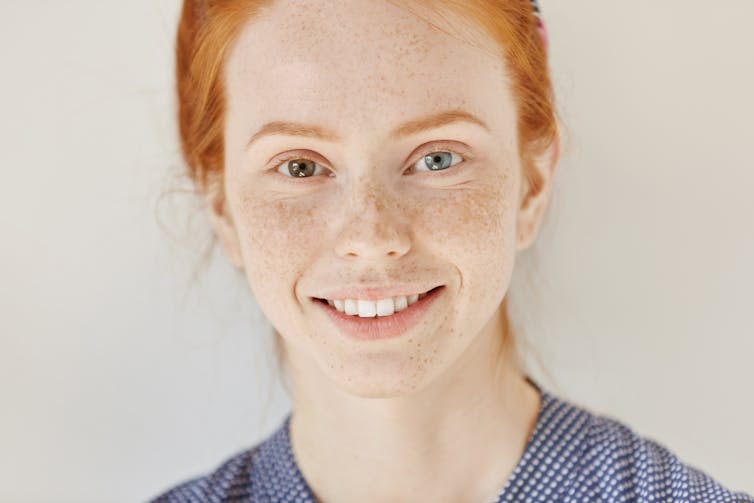Thu 28 March 2024:
“How is eye colour made? And why are they different colours?” – Jane, age 12, from Pascoe Vale South
Hi Jane,
Eyes are so fascinating and I’m glad you asked this question!
When we talk about eye colour, we’re talking about the iris or coloured area around the dark dot (pupil) in the centre of the eye. Like our fingerprints, iris colours are unique to each person.
The most common eye colour is brown, then blue, and less often green or hazel. Pigment means a substance that adds colour. The amazing thing is the human body only makes brown iris pigment (melanin) but not blue, green or hazel iris pigments. So how come everyone doesn’t have brown irises?
‘What colour are your eyes?’
Iris colours can be brown, blue or green, or mixtures such as brown-yellow, greenish brown or blue-brown. The word “iris” comes from the Greek word meaning “rainbow”. In ancient Greek stories, a goddess called Iris carries messages across a rainbow bridge between Earth and the supernatural world.
Genetics – how physical traits and characteristics pass from one generation to the next – play a part in determining eye colour. In many cases, the genes that produce brown eyes are dominant, but how eye colour genes are passed on is complex. This can mean if one biological parent has brown eyes and another has blue eyes, their child is more likely to have brown eyes. But not always.
But what about all the other colours?
So what is the iris made of? Our iris is inside the eye, behind a clear layer called the cornea. It’s circular and very thin (less than half a millimetre) and shaped like a donut with a hole in the middle for our pupil. The iris contains many cells, special muscles, blood vessels and nerves, surrounded by a gel material with millions of tiny crisscrossed fibres.
Iris pigment cells – melanocytes – contain pigment particles (melanosomes). Pigment cell numbers for all iris colours are about the same. But pigment particles inside the cells are different. For example, a blue iris does not have as many pigment particles as a brown iris.
The other iris cells make the tiny fibres and gel material in the iris, and other cells help protect the iris from damage. Special iris muscles with thin stretchy fibres can bunch up or relax the iris to control our pupil size in bright or dim light.
The back of the iris has a dark brown surface because of cells filled with brown pigment. This back surface pigment helps our vision as it stops light scattering through the iris.

Iris colours and patterns are unique to each person, like fingerprints. Shutterstock
White or visible light contains a rainbow spectrum of colours from blue to red. As light passes through the iris, the blue light scatters much more than other colours. So blue light bounces back, and this means that if there are fewer pigment particles, we see a blue iris.
Other colours in light, especially red, scatter less and get into the iris between the tiny fibres, gel and cells. Green, hazel or brown irises have more pigment particles that soak up this light.
So the eye colours we see are a result of the scattering of some light colours more or less than others, brown pigment particles soaking up more of some colours, and the number of pigment particles a person has in their iris.

Some people are born with two different coloured eyes and these don’t change over time. Shutterstock
Can eye colours change?
Iris colours can seem to change if different colours are near the eye. For example, different-coloured eye makeup can “trick” us as to the iris colour we see.
People with little or no iris pigment often have very pale blue irises. These can look reddish without the iris pigment to soak up the red light from inside the eye, which then passes through the iris.
Iris colour does not always stay the same during life. Babies born with blue eyes can have brown or hazel eyes by their second birthday because more dark pigment is made in iris cells after birth.
Iris colour can also change because of rare diseases or injuries.
Some eye drops to treat eye pressure make more brown pigment in iris cells, and make eyes appear browner. Some people are born with one brown eye and one blue eye, but these stay the same with age – although we’re not sure why.
There’s still so much to discover about irises and eye colour!
Author:

Michele Madigan
______________________________________________________________
FOLLOW INDEPENDENT PRESS:
WhatsApp CHANNEL
https://whatsapp.com/channel/0029VaAtNxX8fewmiFmN7N22
![]()
TWITTER (CLICK HERE)
https://twitter.com/IpIndependent
FACEBOOK (CLICK HERE)
https://web.facebook.com/ipindependent
YOUTUBE (CLICK HERE)
https://www.youtube.com/@ipindependent
Think your friends would be interested? Share this story!





